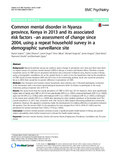| dc.description.abstract | Background
Repeat household surveys are useful to assess change in prevalence over time, but there have been no repeat surveys of common mental disorder (CMD) in Kenya, or indeed sub-Saharan Africa. Therefore a repeat household survey of CMD and its associated risk factors was conducted in Maseno area, Kisumu county in Kenya, using a demographic surveillance site as the sample frame, in order to test the hypotheses that (a) the prevalence of CMD would increase between 2004 and 2013 due to the intervening political, social and economic pressures; (b) as in 2004, there would be no gender difference in prevalence of CMD.
Methods
One thousand one hundred ninety households were selected, and 1158 adult participants consented to be interviewed with a structured epidemiological assessment while 32 refused to participate in the study interviews, giving a response rate of 97.3 %.
Results
The study found that the overall prevalence of CMD in 2013 was 10.3 %. However, there were significantly higher rates of having any CMD in 2013 if one was female (OR 6.2, p < 0.001), divorced/widowed (OR 2.5, p < 0.003), aged over 60 (OR 2.3, p = 0.052), either self-employed (OR 3.3 p < 0.001) or employed (OR 3.3, p < 0.001), or belonged to the lowest asset quintile (OR 2.5, p = .0.004) after adjusting for other variables significant at the bivariate level. The overall prevalence in 2013 was consistent with that found in 2004, despite intervening political and community turbulence. However, this apparent consistency masks the development of a striking difference in prevalence between the genders. Over the decade 2004–13, the prevalence for men dropped from 10.9 to 3.8 % (P = 0.001) and the prevalence for women increased from 10.8 to 17.5 % (p = 0.001).
Conclusion
Common mental disorders continue to pose a significant public health burden in Kenya, and gender related vulnerability merits further research and is relevant for health worker training. | en_US |



